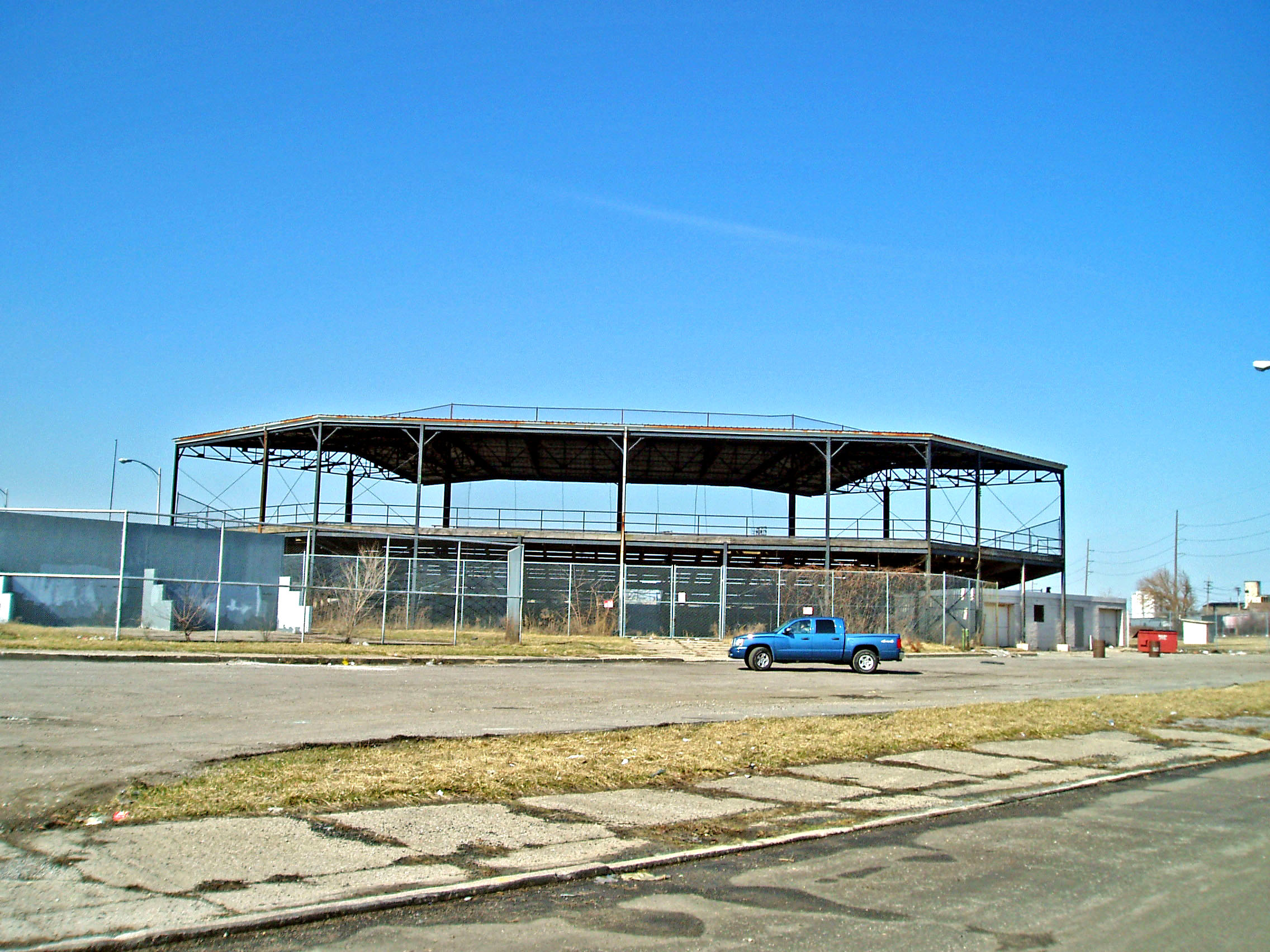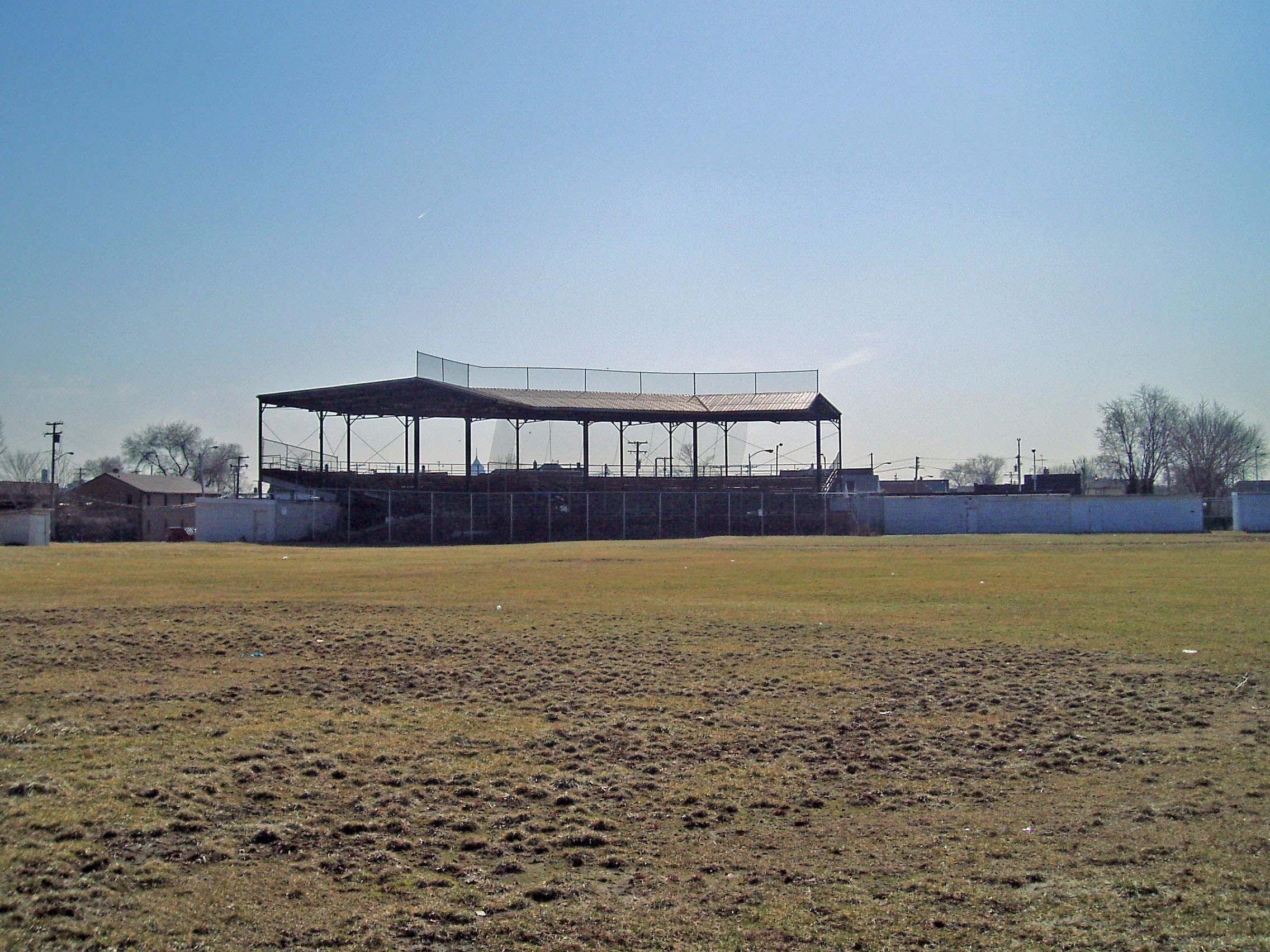

John
A. Roesink, a Dutchman from Grand Rapids, moved to Detroit shortly after
1900 and established one or more men's clothing stores. He had
a strong interest in baseball and sponsored amateur and semi-professional
teams. In the years before World War I, numerous businesses supported
such teams, recruited talented players, and then entered tournaments
and state championships during the summer months with hopes of bringing attention to their enterprises. Roesink was a very
successful sponsor of amateur or semi-professional teams. In 1910,
Roesink built a substantial field for his teams at the corner of Mack and
Fairview on Detroit's east side, Mack
Park. The
park had seating for, perhaps, 6,000, but with standing patrons, crowds may
have exceeded 10,000. Most patrons probably arrived by street cars
on Mack Avenue. In that era, as major league teams traveled from
the East Coast to the Midwest, they regularly played exhibition games with
minor league or semi-pro teams to raise revenue. Roesink's
teams played major leagues squads at Mack Park several times. In 1915,
the upstart Federal League challenged the well-established National and American
Leagues. That up-start league wished to put a franchise in Detroit
using Mack Park. John Roesink, apparently, was a good friend of Frank
Navin who owned the Detroit Tigers. Presumably,
Navin convinced Roesink to refuse a lease for a Federal League team.
In
the 1889s and 1890, a few blacks played for professional baseball teams but
by the mid 1890s, professional baseball adopted a firm Jim Crow policy. Shortly
thereafter, black teams were formed in numerous cities. They played
each other and many amateur or semi-professional white teams. They
also scheduled numerous exhibition games against professional white teams. One
of the more successful early touring black teams was the Paige Giants, sponsored
by a fence company in Adrian, Michigan. Baseball became very popular among
blacks just as it was among whites.
Labor needs during World War I lead to a rapid growth of the African-American population in the large cities of the Northeast and Midwest. Andrew Rube Foster pitched for Negro teams in the early 1900s and then amassed wealth in Chicago, apparently through the numbers business. Many, but not all, of the blacks who became rich in northern cities during World War I were undertakers, real estate brokers or numbers operators. By the end of World War I, Rube Foster realized that the growing and prosperous black population in northern cities would pay to watch professional baseball. To be sure, major leagues allowed blacks to attend their games, but all the players were all white men.
For the summer of 1919, Rube Foster sponsored black baseball teams in a number of large cities including Detroit. This was a trial run to see if a black professional league would generate profits. That team rented John Roesink's Mack Park for their games. The success of Foster's teams in 1919 led him to organize a National Negro league for 1920 with teams in Chicago, Dayton, Detroit, Indianapolis, Kansas City, New York, and St. Louis. I believed that Foster owned all of the teams at the inception of this league, but that apparently changed over time. The team in Detroit, the Detroit Stars, was nominally owned by John T. Blount, a numbers man.
This
league prospered in the early1920s as the growing black middle class paid
to enjoy baseball. The Detroit Stars played in a white neighborhood, and
apparently attracted racially mixed crowds. Indeed, in this area  many
white baseball fans appreciated the exceptional talents of black players
and attended their games. In 1925, John Roesink purchased the Detroit Stars
and became the second white man to own a National Negro League team. Abe
Saperstein who founded the Harlem Globetrotters was the first when he bought
the Kansas City Monarchs baseball team.
many
white baseball fans appreciated the exceptional talents of black players
and attended their games. In 1925, John Roesink purchased the Detroit Stars
and became the second white man to own a National Negro League team. Abe
Saperstein who founded the Harlem Globetrotters was the first when he bought
the Kansas City Monarchs baseball team.
The Detroit Stars were scheduled to play a doubleheader against the Kansas City Monarchs in Mack Park on Sunday July 7, 1929. It was a rainy morning so the start of the first game was delayed so that the grounds crew could burn gasoline on the field to make it playable. Somehow a fire started and a substantial part of the grandstand went up in flames. No lives were lost but many were injured trying to escape the conflagration. Richard Bak, in his book, Turkey Stearns and the Detroit Stars: The Negro Leagues in Detroit: 1919-1933, (Wayne State University Press, 1994) reports that 220 were hurt, but Philip J. Lowry, in his book Green Cathedrals: The Ultimate Celebration of Major League and Negro League Ballparks (New York: Walker & Company, 2006) puts the number at 103 injured.
John Roesink, I believe, continued to operate his clothing stores but must have enjoyed his professional baseball team and the revenue it raised. He had no idea that the Depression was about the kill the Negro baseball leagues and his business. In the fall of 1929, Roesink began building the baseball park pictured above. Apparently he spent $30,000 of his own money for this stadium. The Detroit Stars would play there. In addition, he presumably hoped to rent the field to many amateur teams from the nearby Dodge Main plant. This is a typical baseball park of the pre-Depression era. If you had toured the 500 or so cities in the United States with minor league professional baseball teams in 1948, you would have found dozens of parks almost identical to this one. The steeply pitched grandstand behind home plate is covered by a traditional high and pitched roof. Along the first and third base line, there is much room for bleacher stands or for people to picnic or stand. And the outfield distances are irregular. Lowry lists the distances as 315 feet to left field, 528 to center and 407 to right field. Many baseball parks were built on land that was not desirable for other purposes. Often they were right next to rail lines as this one is. Before Roesink arrived, this site was the home of the Detroit Lumber Company and the Calvert Coal Company, both of them served by the Grand Trunk Railroad before the area was turned into a park.
I
have read comments that this park, similar to Mack Park, was located far
from the Black Bottom area along Hastings Street where many of Detroit's
African Americans resided. However, Hamtramck was an unusual northern community in that many of its neighborhoods and its schools were integrated. At
this time, a black man- John Roxborough - represented Hamtramck in the Michigan
state legislature. He learned Polish so that he could converse in the mother tongue of
his Hamtramck constituents. His brother was the famous and successful promoter of Joe Louis.
John
Roesink recruited Ty
Cobb to throw out the first pitch when the park opened in May, 1930. In
this first season in this park, the Detroit Stars won the second half of the
championship season, qualifying them to play the winners of the first half, the
St. Louis Stars. Alas,
the Mound City Nine won the championship in a seven game series.
John Roesink lost ownership of the Detroit Stars after the 1930 season. I presume this was the result of the Depression. I
have heard that he also lost his clothing stores but I do not know what he did
after his six seasons of leading a successful Detroit Stars team.
In 1931, the National Negro League got their season started, but half way through, went out of business. This proved to be the end of the National Negro League that Rube Foster founded and that prospered from 1920 through 1929. A new league, an East-West Negro League was organized for 1932 but did not survive into July. Detroit had a team in that league and I believed they played Roesink Park. Another new league, also called the National Negro League was organized for 1933, but reflecting the economic crisis of the Depression, terminated its season when half the games were played.
The first night game of professional baseball in Detroit was played at the park you see. Before the 1930s, all baseball games were played in the afternoon, sometimes late in the afternoon. To boost revenue during the Depression, the Kansas City Monarchs traveled with a portable lighting system. On June 28, 1930; the Detroit Stars played the Monarchs at night and drew a crowd of 10,000. Seventeen members of the Cooperstown Baseball Hall of Fame played professional baseball on these grounds. This includes Cool Papa Bell, Satchel Paige, Turkey Stearns - the most accomplished of the Detroit Stars' players - and Smokey Joe Williams.
In January, 2017, the National Park Service, announced a grant of $25,000 to plan a renovation of Roesink Stadium. This was funded through their African-American Civil Rights grants program. Gary Gillette, a long time leader of the Detroit chapter of the Society for American Baseball Research, played a key role in getting this baseball park listed on the National Register of Historic Places and in getting a Michigan State Historical Marker erected here. He announced the formation of a group that would attempt to raise $50,000 in early 2017 for the rehabilitation of the field and, eventually, the rebuilding of the classic grandstand. Mr. Gilette foresees using the field and the adjoining park for baseball, softball and soccer and, reflecting the recent migration of a Bengali population to Hamtramck, cricket.
This is not the only surviving baseball park which once served as the home grounds for a Negro League team but there are very few others. One other is Rickwood Field in Birmingham, Alabama which once hosted the home games of the Birmingham Black Barons. That stadium was built in 1910 and is among the oldest surviving such park in the nation. Another is Hinchliffe Stadium, built in 1932 in Patterson, New Jersey. The New York Black Yankees and the New York Cubans played their home games there. And then there is West Field in Mulhull, Pennsylvania which served as home to the famous Homestead Grays. That field was constructed by the Works Project Administration in 1937.
Date of Construction: October, 1929 to May 1930
Architect or builder: Unknown to me
First baseball game: Saturday May 10, 1930. In a
National Negro League game, the Detroit Stars were defeated by the Cuban
Stars 6-4 in 13 innings.
Official Opening Day: Sunday May 11, 1930. The
Detroit Stars defeated the Cuban Stars 7 to 4.
http://seamheads.com/blog/2009/07/18/the-mack-park-fire/
State of Michigan Registry of Historic Sites: An historical marker was erected at this baseball park in August, 2014.
National Register of Historic Places: Listed in 2012
Use in 2017: Efforts are underway to restore this typical 1920s minor league style baseball park.
Photograph: Ren Farley, April 2, 2008
Description updated: January, 2017
Return to Sports, Parks and Recreation